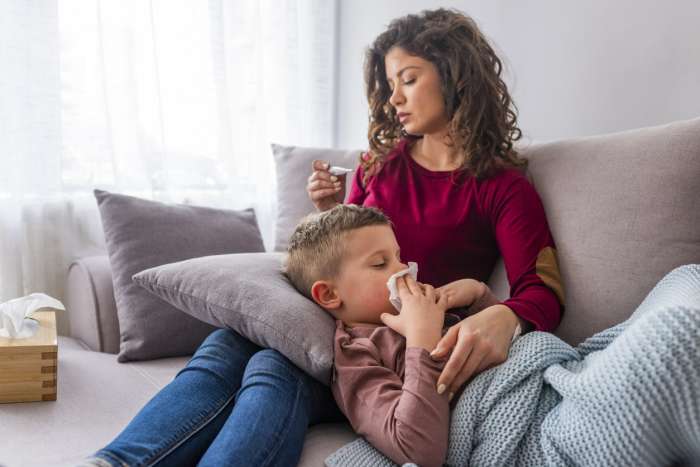The days of packing a box of tissues and sending your littles off to school with a questionably loud cough, low-ish fever and runny nose are long gone in the post-pandemic new normal.
While you know not to send your COVID-positive child to class for at least two weeks, you’re not entirely sure what to do when they come down with another type of illness.
A potentially serious illness such as respiratory syncytial virus (RSV), is a different story. Whether you are planning for flu season in the almost-inevitable illness-fueled autumn and winter months or your child was recently diagnosed with RSV, check out what parents and caregivers need to know about this virus.
Learn how RSV spreads, common RSV symptoms and when to keep your little one home from school or childcare.
What is RSV?
RSV infection is a viral illness that causes, as the name implies, respiratory symptoms. According to the U.S. Centers for Disease Control and Prevention (CDC), this virus causes between 58,000 and 80,000 hospitalizations in children under age five annually.
The CDC notes that common symptoms of this virus in an infected person include a runny nose, coughing, sneezing, wheezing, a decrease in appetite and a fever.
Is Candy and Chocolate Okay for Toddlers?
Dark chocolate has long been toted as a healthy treat that is brimming with antioxidants and beneficial vitamins and minerals. This gives many parents the false impression that it is a good idea to offer this sweet snack to their kids. Read More
While RSV is commonly seen in young infants and young children, older adults are also vulnerable to RSV. This makes prevention, detection and treatment important for people of all ages — especially those who are high-risk or are around high-risk populations.
RSV Symptoms
Unlike older kids, young infants and even toddlers won’t have the ability to describe their symptoms. This means you may need to look for other red flags and common symptoms of RSV such as:
- Increased or out-of-the-norm irritability
- Changes in your child’s breathing
- Wheezing, audible coughing or sneezing
- Fatigue or marked decrease in activity level
RSV Strains to Look Out for in 2023 - 2024
Like the flu, the common cold and COVID-19, RSV isn’t just one viral strain. The two primary variants of RSV are known as A and B, according to the World Health Organization (WHO). In some years, RSV-A is responsible for most of the new cases, while in other years RSV-B is the dominant strain.
RSV-B on the Rise
Research published in the Journal of Medical Virology that looked at the prevalence of the virus in Austria found that while the A was responsible for the 2021/2022 RSV season, RSV-B drove the surge in 2022/2023.
As the seasons change and people spend more time indoors, it’s likely the spread of RSV will increase in most areas. To learn more about the number of cases of RSV in your state, visit the CDC’s Respiratory Virus Activity page. The CDC provides information on the number of cases of respiratory syncytial virus along with the incidence of COVID-19 and the flu.
What’s the Difference Between A Common Cold and RSV?

This is a question that many parents and caregivers have about RSV. As a respiratory illness, it is often mistaken for the common cold (as well as the flu and COVID-19) because symptoms of RSV and the cold often overlap.
Upper Respiratory Tract vs. Lower Respiratory Tract
The common cold typically affects the upper respiratory tract, according to the American Academy of Pediatrics (AAP). This means a kiddo with a cold is more likely to have symptoms associated with this type of infection, such as a runny nose and congestion.
The post-nasal drip that happens when you catch a cold can contribute to a cough, making it seem like your child has RSV. However, a cough caused by a cold vs. a cough caused by RSV is not the same.
RSV is a lower respiratory tract infection and often includes breathing-related symptoms in addition to nasal congestion.
RSV Can Cause Serious Breathing Problems
If your child has trouble breathing, is wheezing, has a high fever or has any other symptom that seems severe, contact the pediatrician right away. Your healthcare provider can offer guidance and test your child for RSV.
The CDC notes that more than 200 viruses can cause the common cold. Colds rarely result in serious health concerns and, provided your child doesn’t already have a weakened immune system, should resolve on their own.
Potential for Infection and Hospitalization
While the symptoms of a cold are annoying and may make it hard for your child to feel comfortable at school, play their favorite sport or go to dance class, most cold symptoms peak within two to three days of onset and can last up to 14 days.
Likewise, RSV may last for up to two weeks. That said, this virus can cause a more serious infection of the lungs, such as pneumonia or bronchiolitis. These complications could require hospitalization and treatments such as intubation, IV fluids or additional oxygen.
How is RSV Spread?
Respiratory syncytial virus is extremely contagious. This virus is passed from person to person and spreads through coughing, sneezing or via direct contact after touching an infected surface.
This makes it possible for the virus to spread in areas of close contact, such as a childcare center or an elementary school. According to the CDC, some people are contagious one to two before they develop symptoms and remain contagious for about three to eight days.
How Long Should A Kid Stay Home with RSV?
Given that RSV is contagious before a person has symptoms, you may not be able to stop your kiddo from giving their BFFs the virus at school or in childcare. But this doesn’t mean you should go ahead and send them out into public after they start coughing and sniffling.
Even though most people are only contagious for three to eight days, some people (especially young infants) can spread the disease for up to four weeks.
Still, these longer cases are generally uncommon, so it’s not likely that you will have to keep your little one home for a full month. Most children feel better within a week to two, making it possible to return to school and other normal daily activities.
Always follow your child’s school or daycare center’s sick policy. Most educational environments and group settings have always had guidelines for when to send/keep a child home from school.
Check Your School and Daycares Sick Policy Guidelines
These sick policies kicked into high gear during the pandemic. Common school/daycare illness policies require children to stay home for at least 24 hours after a fever subsides or during an active GI infection.
Allow Enough Time for Recovery
However, parents should not give a child with a fever ibuprofen or acetaminophen to bring down their temperature and then send them in for a day of learning.
In general, it’s best to keep your child home while they are actively ill and exhibit symptoms. Not only can this reduce the spread of the highly contagious virus, it gives your child the time they need to feel better.
While most children will only have mild to moderate symptoms, the cough, nasal congestion and other not-so-pleasant parts of RSV can easily interfere with your child’s ability to effectively make it through their school day.

Tips for Preventing RSV
How can you stop the spread of RSV or help your child avoid the illness? Think about everything the pandemic has taught us.
-
Frequent Handwashing and Hand Sanitizer
Hand washing is a top tool in virus prevention. Even though direct contact with an infected person is a primary way to get this virus, your child could also pick it up from doorknobs, desks, a water fountain or anything else that they touch.
Like hand washing, staying socially distant (another pandemic-time pick) from sick people can also help your child avoid RSV.
-
RSV Antibody Immunizations
In August of 2023, The CDC announced a new long-lasting monoclonal antibody product, which has been shown to reduce the risk of both hospitalizations and healthcare visits for RSV in infants by about 80 percent.
This new RSV immunization known as nirsevimab (brand name Beyfortus ™) is FDA-approved and will be available widely as of October 2023.
The CDC recommends vaccinations for some higher-risk people. These include people who are 32 to 36 weeks pregnant during peak RSV season — September through January.
Not only can the vaccine protect the mother, but it also can provide some level of immunization against the disease for the baby from birth through six months.
Along with pregnant people, the CDC also recommends that babies who are born during RSV season, are younger than eight months and have mothers who were not vaccinated against the virus during pregnancy should get the RSV antibody immunization.
Infants and toddlers eight to 19 months who have weakened immune systems, severe cystic fibrosis or have chronic lung disease should also have a dose of the antibody, according to the CDC.
Do you want to learn more about avoiding other viral illnesses? We’ve got the info you need on the common cold right here!



